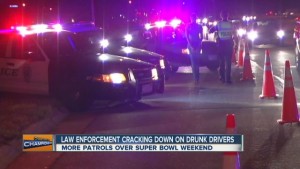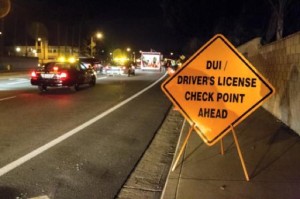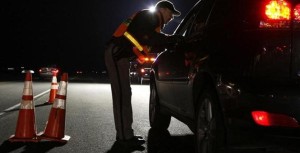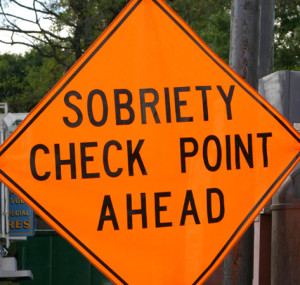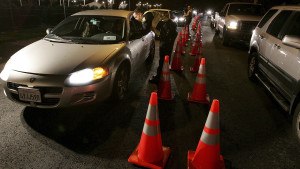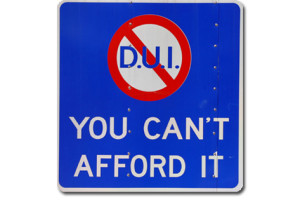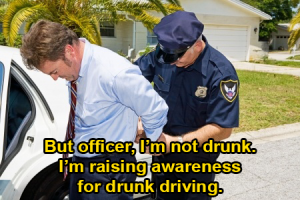Why DUI Checkpoints Are A Bad Idea
Why DUI Checkpoints Are A Bad Idea
DUI Checkpoints are Not Effective at Finding Drunk Drivers.
DUI Checkpoints are a bad idea. They are not especially helpful in apprehending persons driving under the influence. With support from groups such as Mothers Against Drunk Driving, California more than doubled its use of sobriety checkpoints the past three years.
While drunk driving checkpoints cause traffic jams and frustrate drivers, they rarely catch motorists who are under the influence. Statistics show that sobriety checkpoints are actually a poor way to crack down on drunk driving. DUI Saturation Patrols, which have officers with training in detecting persons driving impaired, have substantially higher arrest rate. Measured in arrests per working hour, these saturation patrols are statistically the most effective method of apprehending drunken drivers (Greene, 2003).
Dennis Kenney, a professor of criminal justice at New York’s John Jay College of Criminal Justice, states that DUI checkpoints are not cost effective. “They freeze up a certain amount of resources standing out there on the side of the road. They tend to tie-up traffic,” he says. That makes another reason why DUI checkpoints are a bad idea.
Some critics of DUI checkpoints maintain that they strip away individual rights. “I think there ought to be a high burden of proof for randomly stopping people with no prior evidence that they’re alcohol-impaired,” says Robert Poole, director of transportation policy at the libertarian Reason Foundation. “If the car’s weaving around, certainly. Otherwise, I think that’s a violation of civil liberties. In effect, it’s an illegal search.” (However, even saturation patrols have to have probable cause for a DUI stop).
DUI Checkpoints make unbelievable money for law enforcement.
DUI checkpoints can be an especially lucrative operation for law enforcement agencies, which catch and impound unlicensed drivers (impound fees for 30-60 days can run into thousands) and receive money in funds from the Federal and State governments, and MADD, which typically go 100% towards officer overtime.
An investigation by the Investigative Reporting Program at UC Berkeley with California Watch has found that impounds at checkpoints in 2009 generated an estimated $40 million in towing fees and police fines—revenue that cities divide with towing firms. In addition, police officers received about $30 million in overtime pay for the DUI crackdowns, funded by the California Office of Traffic Safety. The Federal National Highway Transportation Safety Administration (NHTSA), also contributes funds, and MADD sometimes contributes funds to police departments.
The federal government provides the California Office of Traffic Safety about $100 million each year to promote responsible driving that reduces roadway deaths. Of that, $30 million goes into programs that fund drunken driving crackdowns, particularly checkpoints.
The additional dozen officers typical at a California roadway operation cost state and federal taxpayers an extra $5.5 million during the 2008-09 fiscal year, according to the Investigative Reporting Program’s analysis.
The state data shows that last fiscal year LAPD spent $16,200 per checkpoint, all of it on officer overtime. Every penny. That’s why DUI checkpoints are a bad idea.
DUI Checkpoints have an overtime incentive.
Police officer overtime accounts for more than 90 percent of the expense of sobriety checkpoints. Departments do not assign officers to work checkpoints during their regular shifts. And law enforcement agencies tend to use more officers than a checkpoint requires, according to guidelines established by the National Highway Traffic Safety Administration.
In the State of California, police departments on average deployed 18 officers at each checkpoint, according to state data. The federal traffic safety agency advises that police can set up DUI checkpoints with six officers. Departments frequently over staff checkpoints, so all officers that want to can earn their overtime.
The Moreno Valley Police Department in Riverside County averaged 38 officers at each operation last year, six times more than federal guidelines say is required. Nearly 50 other local police and sheriff’s departments in California averaged 20 or more officers per checkpoint – operations that averaged three DUI arrests or less a night. The LAPD sent 35 officers, on average, to every sobriety checkpoint in Los Angeles.
Comparing that again to Saturation Patrols, last year, a California traffic deputy single-handedly caught more than 100 drunk drivers while working a one-woman saturation patrol.
For every police officer who is stationed at a DUI checkpoint stopping vehicles, that is one less police officer available to look for really dangerous drunks driving the wrong way down the highway, or drivers weaving back and forth because they are texting, talking on their phone or eating, all of which have higher death rates and slower reaction times than DUI.
The National Motorists Association has questioned whether overtime pay is a conflict that drives over-aggressive enforcement. The way the grants are structured, “police feel pressure,” they have stated, “to hit ticket quotas so they can continue to get money.”
Th eCalifornia Watch Article also, states
“Sobriety checkpoints in California are increasingly turning into profitable operations for local police departments that are far more likely to seize cars from unlicensed motorists than catch drunken drivers.”
DUI Checkpoints and DUI Patrols mainly seize and impound vehicles of drivers NOT under the influence, solely for profit.
One sad fact about checkpoints is that DUI Checkpoints are far more likely to seize cars from unlicensed motorists than find drunk drivers. While those found to be DUI can have their car released immediately, those that don’t have insurance, or a license, mainly the poor, face mandatory impounds and huge fees to get their vehicles back, in most cases causing abandonment of the car altogether.
Owners who do recover their vehicles pay between $1,000 and $4,000 in tow and storage charges and fines assessed by local governments. In the course of its examination, the UC Berkeley Investigative Reporting Program reviewed hundreds of pages of city financial records and police reports and analyzed data documenting the results from every DUI checkpoint that received state funding during the past two years. Among the findings of the Investigative Reporting Program:
• Sobriety checkpoints frequently screen traffic within, or near, Hispanic neighborhoods. Cities, where Hispanics represent a majority of the population, are seizing cars at three times the rate of cities with small minority populations. In South Gate, a Los Angeles County city where Hispanics make up 92 percent of the population, police confiscated an average of 86 vehicles per operation last fiscal year.
• The seizures appear to defy a 2005 federal appellate court ruling that determined police cannot impound cars solely because the driver is unlicensed. In fact, police across the state have ratcheted up vehicle seizures. Last year, officers impounded more than 24,000 cars and trucks at checkpoints. That total is roughly seven times higher than the 3,200 drunken driving arrests at roadway operations. The percentage of vehicle seizures has increased 53 percent statewide compared to 2007.
Reporters, like on in this San Diego television report, confirmed that police are impounding more cars from sober drivers than drunken drivers at sobriety checkpoints, which earn tens of millions of dollars for California cities and law enforcement agencies. A report by PBS found the same thing.
In Chicago, studies showed people were generally cited at DUI Sobriety Checkpoints for no insurance, broken taillights, and minor “fix it” ticket infractions, but not DUI. 93% of actions overall were not DUI related over all DUI Checkpoint.
Each DUI checkpoint, however, resulted in an $853,000 money grant from NHTSA, plus citation revenues for the City of Chicago.
John Bowman, a spokesman for the Wisconsin-based National Motorists Association, a drivers’ advocacy organization, says “The bottom line on the DUI checkpoints, they’re not necessarily about checking people for DUI. They’re meant for screening drivers for technical violations or insurance … (under) a guise of public safety.” That’s why DUI checkpoints are a bad idea.
Some States have held DUI Checkpoints to Be Illegal.
Sobriety checkpoints have been used for the last 25 years in the United States, withstanding several legal challenges. But in 10 states (Idaho, Iowa, Michigan, Minnesota, Oregon, Rhode Island, Texas, Washington, Wisconsin, Wyoming), states have decided to ban sobriety checkpoints altogether, and one state chooses not to conduct them at all under any circumstance (Alaska).
As a result of new laws and increased law enforcement operations, from 1982 to 1997, alcohol-related traffic fatalities in the United States decreased about 2 percent each year, a 36 percent overall reduction. Mothers Against Drunk Driving (MADD), but sobriety checkpoints have remained a constant enforcement component of DWI prevention.
DUI Checkpoints must have Advance Publicity, which Makes Them Easy for Drunk Drivers to Avoid.
DUI checkpoints are highly visible by design and often publicized in advance—and thus extremely easy to avoid. This is why DUI checkpoints are a bad idea – everyone knows where and when to avoid them.
In evaluating whether or not a DUI checkpoint is legal, courts generally require that there be procedures utilized that don’t leave discretion to the officer at the checkpoint. See Delaware v. Prouse, 440 U.S. at 662, 99 S.Ct. 1391. The Louisiana Supreme Court decision in State v. Jackson764 So.2d 64, 72-73, (La., 2000) illustrates the considerations that courts generally employ to determine the validity of sobriety checkpoints. Those are as follows:
- The location, time and duration of a checkpoint, and other regulations for operation of the checkpoint should be established (preferably in written form) by supervisors or other administrative personnel rather than the field officers implementing the checkpoint;
- Advance warning to the approaching motorist with signs, flares and other indications to warn of the impending stop in a safe manner and to provide notice of its official nature as a police checkpoint;
- Detention of the motorist for a minimal length of time; and
- Use of systematic non-random criteria for stopping motorists.
Under the Ingersoll case here in California, it’s required that police give notice of a checkpoint. In fact, you’ve probably seen headlines in your local paper or read a tweet from the police department warning residents of an upcoming sobriety checkpoint, disclosing precisely when and where the screening will take place. DUI Specific Apps exist for that purpose. Press releases from Police Agencies exist to let people know about it. This leads to another reason why DUI checkpoints are a bad idea – those that plan ahead and are the most dangerous serial drunk drivers, or alcoholics, are the least likely to be caught in a DUI checkpoint for that reason.
Even Police Officers say that DUI Checkpoints are not effective, and a Waste of Their Time.
Some officers also feel that sobriety checkpoint duty result in few arrests and aren’t very productive. See: http://www.policechiefmagazine.org/magazine/index.cfm?fuseaction=display_arch&article_id=637&issue_id=72005
Law enforcement press releases constantly state that the main goal of DUI checkpoints is just awareness, not public safety or arrests. Awareness can be accomplished by other means, and MADD, in particular, does a good job of awareness. Not many people do not know that driving under the influence is illegal. There have been many high-profile DUI awareness campaigns over the years sponsored by government media action. Everyone is familiar with the phrase “don’t drink and drive.” These less expensive, less constitutionally-intrusive public awareness campaigns make more sense than DUI checkpoints — if awareness is the goal.
Barbara Harsha, executive director of the Governors Highway Safety Association, even admits as much. “The goal is not to write tickets or make arrests but rather to remind the public that they should drive sober or face serious consequences.”
But Riverside County, where Riverside DUI cases and Murrieta DUI cases have a high rate of arrest, disagrees. Riverside County Sheriff Stanley Sniff, whose deputies made 491 DUI arrests at 83 checkpoints in 16 cities last year, says: “patrols are still the most effective. We make light-years more arrests on random patrols than at checkpoints.
So what should you do if you face an OC DUI Checkpoint? When approaching a DUI Checkpoint the best thing to do is remain calm, follow the officer’s instructions as well as the flow of traffic. Asking for proof of ID and registration is not in violation of your civil rights and the practice of traffic stops has been upheld by the Supreme Court to help protect the safety and well being of all drivers on the road.
You can also politely refuse all field sobriety tests, refuse to answer any questions about drinking, and politely refuse the field breathalyzer, but would have to take a blood or breath test for evidential purposes or lose your license for one year.
No one wants drunk drivers on the road. But no one wants texters or people eating lunch on the road, or people with children in the car either, which statistically is even more dangerous, and result in way more deaths. Making a system that is fair to all and puts officers where they can do their best, is good policy.
If you have questions about Orange County DUI Checkpoints, or why DUI checkpoints are a bad idea, contact our firm at (949) 682-5316. We are here to help in any way with an Orange County DUI case.


